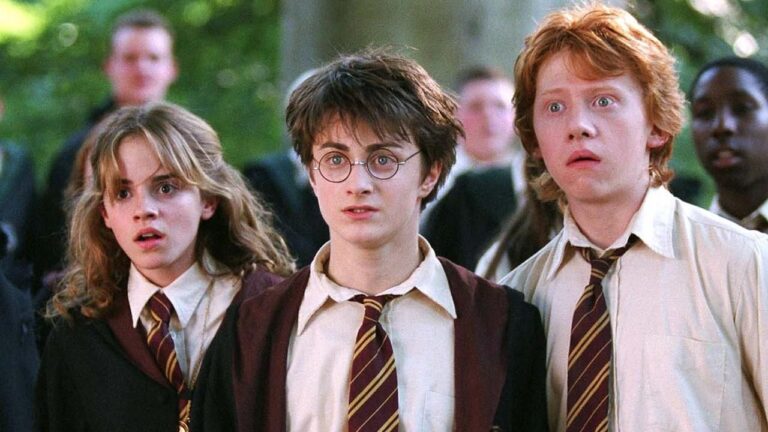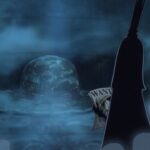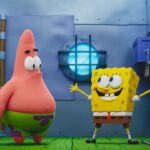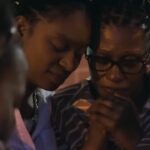‘Harry Potter and the Prisoner of Azkaban‘ is often considered an important point in J.K. Rowling’s series. It is the book where the story grows darker and more complex. In his third year at Hogwarts, Harry faces the threat of Sirius Black, a prisoner who has escaped from Azkaban and is believed to be after him. The book lets us follow Harry’s thoughts closely, showing his fears, frustrations, and determination.
It also reveals more about his parents and their friends. We meet new magical elements, including the Marauder’s Map, Buckbeak the Hippogriff, and the Dementors, which affect Harry deeply. These details help us understand the characters and the world they live in, making the story richer and more immersive.
Visual Depth and Narrative Condensation in Harry Potter and the Prisoner of Azkaban

The movie directed by Alfonso Cuarón takes a different approach, as the third installment of the representation of Hogwarts looks darker and more mysterious. The rain, shadows, and fog give the castle a haunting feel. After all, the characters are growing older and the story is becoming more serious. The film emphasizes visual storytelling, which allows us to feel the mood and tension. You can see fear and danger in the way scenes are framed, but the movie cannot fully show Harry’s inner thoughts. We see his reactions and expressions, but we do not get the same access to his feelings and reflections that the book gives us.
The plot of the book is carefully built, especially when we discover that Peter Pettigrew betrayed Harry’s parents. We follow clues and conversations that lead us to this revelation. The Marauders’ history, showing James, Sirius, Remus, and Peter as friends, gives us insight into loyalty, mistakes, and the bonds of friendship. The movie simplifies much of this. The Marauder’s Map appears, and the identities of the Marauders are explained, but the story moves quickly. Some fans feel that the suspense and emotional weight are reduced because the history behind the betrayal is not fully shown.
The Dementors are another point where the book and movie differ. In the novel, they affect Harry emotionally as much as physically. We understand his fear, despair, and the lingering effect they have on him. In the film, the Dementors are frightening to watch and very well designed, but the focus is on how they look and move rather than how they affect Harry inside. This is one of the moments where we realize that a visual medium cannot always show the same inner experience that a book can.
The Time-Turner sequence is another example. In the book, Hermione plans everything carefully. We see how she arranges the timing to save Buckbeak and Sirius. We understand her thinking and reasoning. In the movie, the sequence is condensed. You can follow the main events, but the detailed planning and Hermione’s cleverness are less obvious. Fans often say that this makes the story feel faster, but that we miss some of the intellectual satisfaction that comes from reading the book.
The Art of Portraying Growth: Differences in Character Development Between Text and Film

Character development also changes between the book and the movie. In the book, we understand Harry’s thoughts and emotions, which show his growth as he faces fear, betrayal, and moral choices. We see Hermione’s intelligence and strong sense of right and wrong. Ron’s loyalty and determination are clear. Lupin’s struggles as a werewolf and his compassion are explored in depth. In the movie, we rely more on actors’ expressions and visual cues to feel these traits. While the performances are excellent, we do not get the same level of reflection.
Despite these differences, both the book and the movie achieve something important. The novel gives us the full story with all its twists and character depth. The movie creates a visual world that feels alive and real, and it captures the suspense and danger of Harry’s third year. Together, they let us experience the story in two ways. You can read the book to understand thoughts and details, and watch the movie to feel the atmosphere and see the magic brought to life.
Harry Potter and the Prisoner of Azkaban shows us how different media tell a story in different ways. The book lets us enter Harry’s mind, understand the Marauders’ history, and follow the careful planning of Hermione and Harry. The movie lets us experience Hogwarts through images and movement, showing danger, mystery, and the growing maturity of the characters. After all, both are valuable. We can enjoy the book for its depth and the movie for its artistry. They complement each other, giving us a full experience of the story, the magic, and the challenges Harry faces in his third year.




